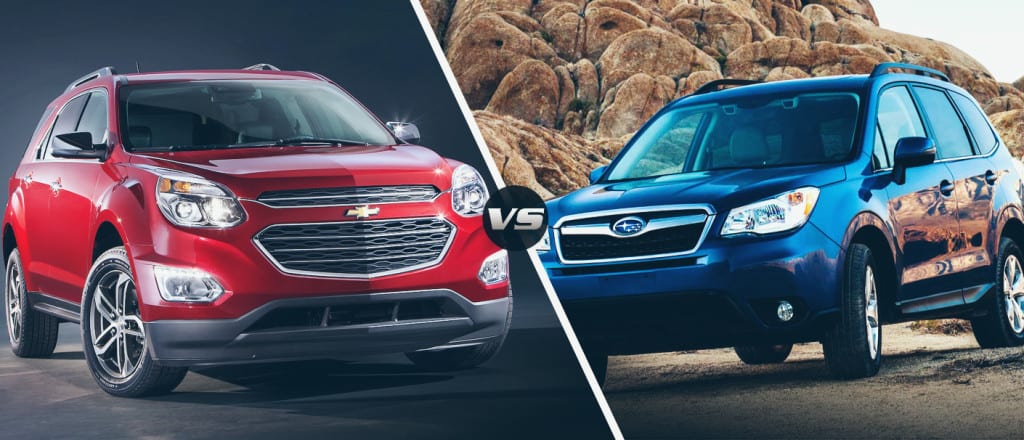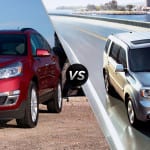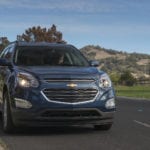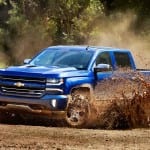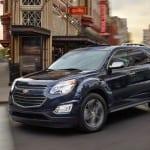The Subaru Forester is one of the more well-know crossover SUVs out there, so how will the returning 2016 Chevy Equinox match up to it? For years people have praised the Subaru name, and the Equinox is going to need a few tricks up it’s sleeve to help it on the market. Thankfully, it’s back with a new look and a new trim level structure that is sure to help pump up sales, along with some other much needed improvements. The Forester isn’t going to be easy though, and is holding a few of it’s own aces.
Trim Levels
The Equinox has four new trim levels: the L, LS, LT, and LTZ that all sport some pretty appealing features. The standard L trim level comes naturally with automatic headlights, air-conditioning, premium cloth upholstery, an adjustable power driver seat, 60/40-split back seats that are able to recline, cruise control, a trip computer, and a tilt-and-telescoping steering wheel. As far as comfort goes, it doesn’t seem too bad. The leather seating will be sorely missed, but other than that all the basic necessities are there.
It isn’t looking too bad for technology either; the L trim is led by a 7-inch touchscreen interface that is capable of OnStar technology, Bluetooth connectivity (no audio), 4G WiFi hotspot, a rearview camera, and six-speaker sound system with aux. input and USB capabilities.
Forester
The Forester is available in six trim levels: the 2.5i, 2.5i Premium, 2.5i Limited, 2.5i Touring, 2.0XT Premium and 2.0XT Touring. The Forester provides two more trim levels than the Equinox, which hints at the idea of more additional options. Even so, the baseline trim is comparable to the Equinox’s, but not completely. There are still a few differences between the two.

The first and most noticeable difference is the 6.2-inch touchscreen the 2.5i has as opposed to the 7-inch one in the Equinox. The Equinox also boasts a sound system that as 2 more speakers, as well as more options in terms of adjusting the drivers seat. On the 2.5i side of things, the Bluetooth connectivity has audio (unlike the Equinox), as well as a rearview mirror. Both models have their own form of safety/interface technology paired with the touchscreen, and both sit 17-inch alloy wheels.
The baseline trims seem to be competitively matched, each having strengths and weaknesses, with both offering a plethora of additional options too make up for anything you feel is lacking.
The only major difference I can see that gives the Forester an edge is all trim levels come with AWD capability, something that is only reserved for the higher level trims in the Equinox.
Overall Design
The overall design of these two vehicles is where differences become more noticeable. They are both sporting contemporary looks in terms of appearance and design, but the Equinox’s redesign is far more noticeable, and much more handsome. The Forester still look a little ridged in my opinion, whereas the Equinox has strong and flowing contour lines that compliment the overall concept well.

On the engineering side of things, the Subaru Forester is a little more compact than the Equinox. It comes in at around 180.1 inches in length, 66.4 inches in height, and 70.7 inches in width. The Equinox is sitting at 187.8 inches in length, 66.3 inches in height, and 72.5 inches in width. Naturally, you would think this would cause the Equinox to have a little more wiggle room than the Forester, which it doesn’t.
In terms of overall passenger volume, the Forester actually beats the Equinox. The Forester has 108.3 cubic-feet of passenger room, and the Equinox has 99.7 cubic-feet. Somehow, this means the Forester has more cargo room as well. With 34.4 cargo room with the back seats folded up, it beats out the Equinox that sits at 31.5 cubic-feet of storage.
This spec heavy paragraph essentially means that the Forester (even though it is smaller in size than the Equinox) has more overall space inside the vehicle. An engineering marvel, if you ask me. Even so, the difference between dimensions of these vehicles is essentially negligible.
Engines and Performance
The standard engine in the 2.5i Forester sports a 2.5-liter four-cylinder engine that puts out 170 horsepower and 174 pound-feet of torque. The baseline trim (and all the rest) are all naturally paired with a six-speed manual transmission, with a CVT transmission optional. The higher trims only come with the CVT automatic, which might be a disappointment for traditional Subaru lovers who want the higher trims to be paired with a manual.
The baseline trim is able to do 0 to 60 in 9 seconds equipped with a CVT transmission, and gets 24 mpg city, 32 mpg highway (27 mpg combined). With the standard manual transmission, this drops too 22 mpg city, 29 mpg highway, giving it 25 combined.
Both the Forester and the Equinox offer much stronger engine options paired to the higher trims. For the Forester, the 2.0-liter four-cylinder lets the 2.0XT put out 250 horsepower and 258 pound-feet of torque. But, this engine only comes with the CVT since it’s only offered in the higher level trims. The mpg sits at 23 city, 28 highway, and 25 mpg combined with this engine option and trim. Spending extra money gets you the same mpg as the baseline trim when equipped with a manual transmission, but it gets you more speed. The 2.0XT is able to do 0-60 in just 6.3 seconds, which is impressively quick for a vehicle in this category.
Equinox
The base engine on the Equinox is a 2.4-liter four-cylinder, and it’s paired with an automatic transmission. The base engine puts out 182 horsepower with 172 pound-feet of torque, getting more horsepower than the Forester. However, it can only do 0 to 60 mph in 9.8 seconds, which is much slower than the Forester’s baseline model. It can also only tow up to 1500 pounds as well, so the utility is just the same. The base trim Equinox gets 26 mpg combined, which is relatively the same as the Forester.
It seems that in terms of performance, the first two trim levels are beat out by the Forester… only the first two.

Since this is a crossover SUV, people are looking for torque and utility, not speed. The V6 offered in the two higher trim levels completely crushes any of the engines offered in the Forester’s six trims. The 3.6-liter V6 puts out 301 horsepower and 272 pound-feet of torque, a significant increase in both areas. However, even though this engine is on par with the Forester for the 0 to 60 mph test, the EPA fuel rating is not.
Even with front wheel drive, the Equinox equipped with the V6 can only get 20 mpg combined. The fuel economy in this higher trim Equinox is devastating, but because the Equinox puts out more torque, it’s better for utility purposes, especially in the higher trim. A properly equipped Equinox can tow up to 3,200 pounds, which is almost double the amount of the best equipped Forester, so it’s safe to say the loss in fuel economy is justified.
In Conclusion
Based on what we have seen, the only significant difference between these two vehicles is the performance. The Forester is able to accelerate only a little quicker, but if you are okay with about a half a second difference in time, then the Equinox is the way to go. The higher trims offering far more power, torque, and towing capacity. Both models are competitively priced; the Forester starting at $22,395 going up to $30, 795, and the Equinox starting at $22,600 going up to $30,635. Taking everything into account, it looks like the Equinox is going to be able to hold it’s own against the Forester on the market. Possibly even pulling ahead if consumers don’t mind the hit in fuel-economy the Equinox takes, which is justified by the increase in torque and horsepower.
